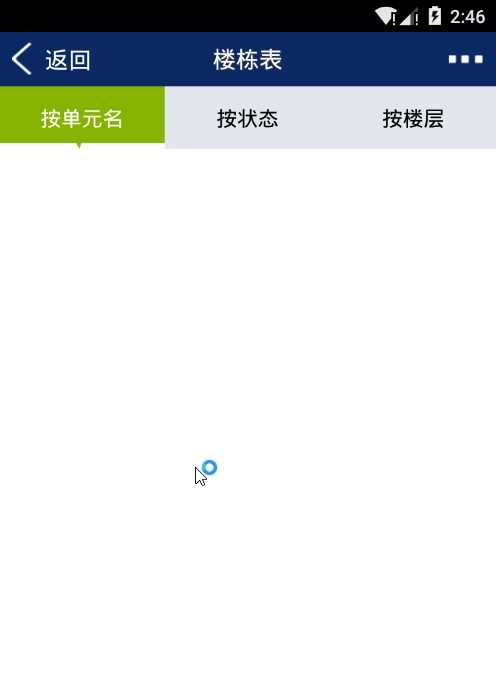标签:




界面比较简单,要想做得漂亮换几张图片就可以了。
第一步:先在布局(这里用了main.xml创建时自动生成的)里面放上TabHost ,只要将TabHost控件托至屏幕中就可:
<?xml version="1.0" encoding="utf-8"?> <TabHost xmlns:android="http://schemas.android.com/apk/res/android" android:id="@+id/taskdescribe_buildingmeter_tabhost" android:layout_width="match_parent" android:layout_height="match_parent" android:background="@color/white" > <LinearLayout android:layout_width="match_parent" android:layout_height="match_parent" android:orientation="vertical"> <TabWidget android:id="@android:id/tabs" android:layout_width="match_parent" android:layout_height="wrap_content"> </TabWidget> <FrameLayout android:id="@android:id/tabcontent" android:layout_width="match_parent" android:layout_height="0dp" android:layout_weight="1"> <LinearLayout android:id="@+id/buildingmeter_layout_unitname" android:layout_width="fill_parent" android:layout_height="fill_parent" android:orientation="vertical" android:background="@color/white"> </LinearLayout> <LinearLayout android:id="@+id/buildingmeter_layout_installstatus" android:layout_width="fill_parent" android:layout_height="fill_parent" android:orientation="vertical" android:background="@color/white"> </LinearLayout> <LinearLayout android:id="@+id/buildingmeter_layout_storey" android:layout_width="fill_parent" android:layout_height="fill_parent" android:orientation="vertical" android:background="@color/white"> </LinearLayout> </FrameLayout> </LinearLayout> </TabHost>
第二步:创建显示此TabWidget的布局tab项tabmini.xml:
<?xml version="1.0" encoding="utf-8"?> <LinearLayout xmlns:android="http://schemas.android.com/apk/res/android" android:layout_width="match_parent" android:layout_height="40dip" android:paddingLeft="5dip" android:paddingRight="5dip"> <TextView android:id="@+id/tab_lable" android:layout_width="match_parent" android:layout_height="match_parent" android:gravity="center" android:text="TextView" /> </LinearLayout>
第三步:在Activity里实现TabHost:
private TabHost tabHost; private TabWidget tabWidget;
LayoutInflater inflater = activity.getLayoutInflater(); View view1 = inflater.inflate(R.layout.tabhost_tag, null); TextView txt1 = (TextView) view1.findViewById(R.id.tab_lable); txt1.setText("按单元名"); View view2 = inflater.inflate(R.layout.tabhost_tag, null); TextView txt2 = (TextView) view2.findViewById(R.id.tab_lable); txt2.setText("按状态"); View view3 = inflater.inflate(R.layout.tabhost_tag, null); TextView txt3 = (TextView) view3.findViewById(R.id.tab_lable); txt3.setText("按楼层"); //得到TabHost对象实例 tabHost =(TabHost) activity.findViewById(R.id.taskdescribe_buildingmeter_tabhost); //调用 TabHost.setup() tabHost.setup(); tabWidget = tabHost.getTabWidget(); //创建Tab标签 tabHost.addTab(tabHost.newTabSpec("one").setIndicator(view1).setContent(R.id.buildingmeter_layout_unitname)); tabHost.addTab(tabHost.newTabSpec("two").setIndicator(view2).setContent(R.id.buildingmeter_layout_installstatus)); tabHost.addTab(tabHost.newTabSpec("three").setIndicator(view3).setContent(R.id.buildingmeter_layout_storey)); //设置第一次打开时默认显示的标签 tabHost.setCurrentTab(0); //初始化Tab的颜色,和字体的颜色 updateTab(tabHost); //选择监听器 tabHost.setOnTabChangedListener(new tabChangedListener());
/** * 更新Tab标签的颜色,和字体的颜色 * @param tabHost */ private void updateTab(final TabHost tabHost) { for (int i = 0; i < tabHost.getTabWidget().getChildCount(); i++) { View view = tabHost.getTabWidget().getChildAt(i); TextView tv = (TextView) tabHost.getTabWidget().getChildAt(i).findViewById(R.id.tab_lable); tv.setTextSize(16); tv.setTypeface(Typeface.SERIF, 0); // 设置字体和风格 if (tabHost.getCurrentTab() == i) { //选中 view.setBackground(getResources().getDrawable(R.drawable.tabhost_current));//选中后的背景 tv.setTextColor(this.getResources().getColorStateList(android.R.color.white)); } else { //不选中 view.setBackground(getResources().getDrawable(R.drawable.tabhost_default));//非选择的背景 tv.setTextColor(this.getResources().getColorStateList(android.R.color.black)); } } } /** * TabHost选择监听器 * @author * */ private class tabChangedListener implements OnTabChangeListener { @Override public void onTabChanged(String tabId) { tabHost.setCurrentTabByTag(tabId); updateTab(tabHost); } }
Android 自定义TabHost,TabWidget样式
标签:
原文地址:http://www.cnblogs.com/guop/p/5033081.html